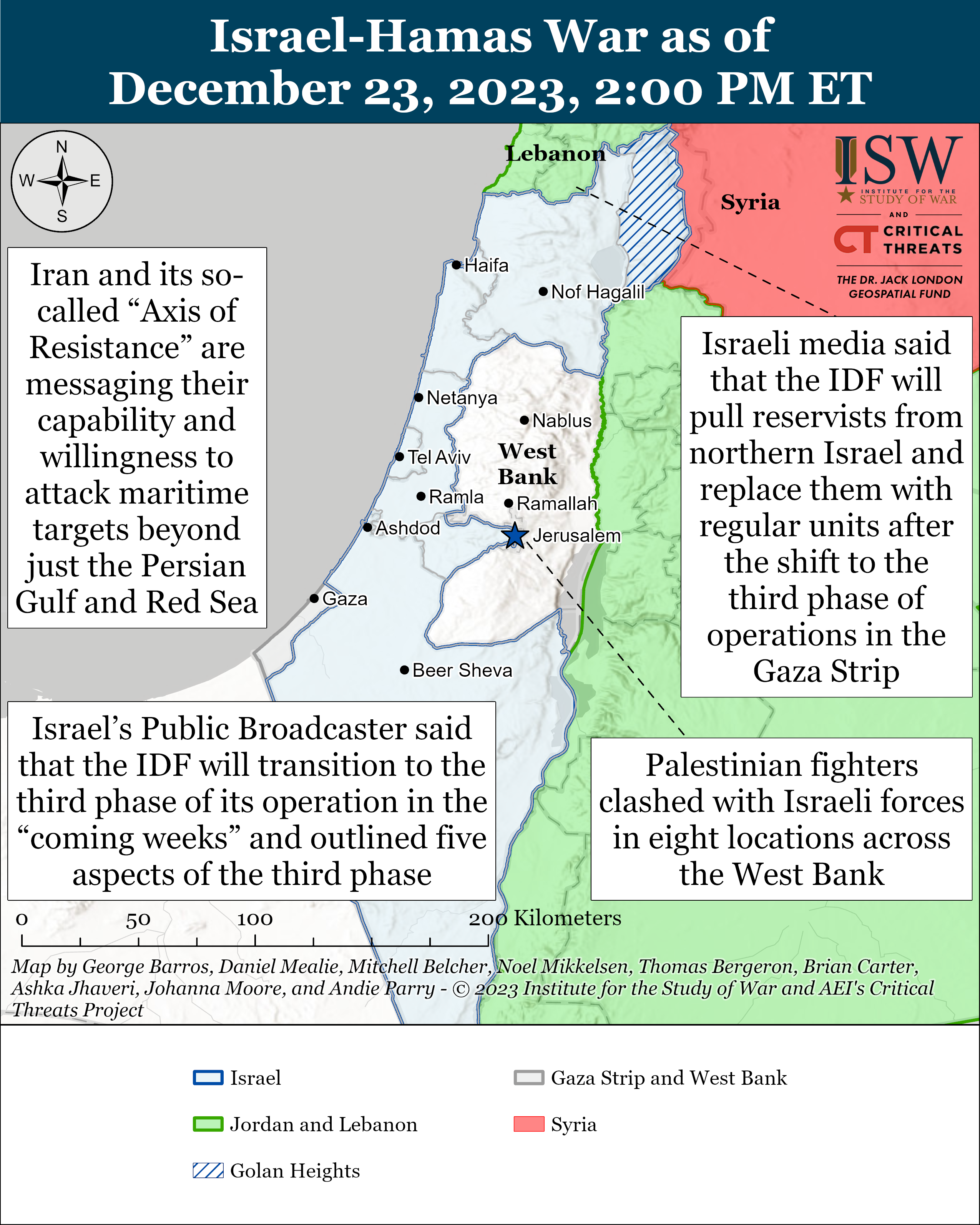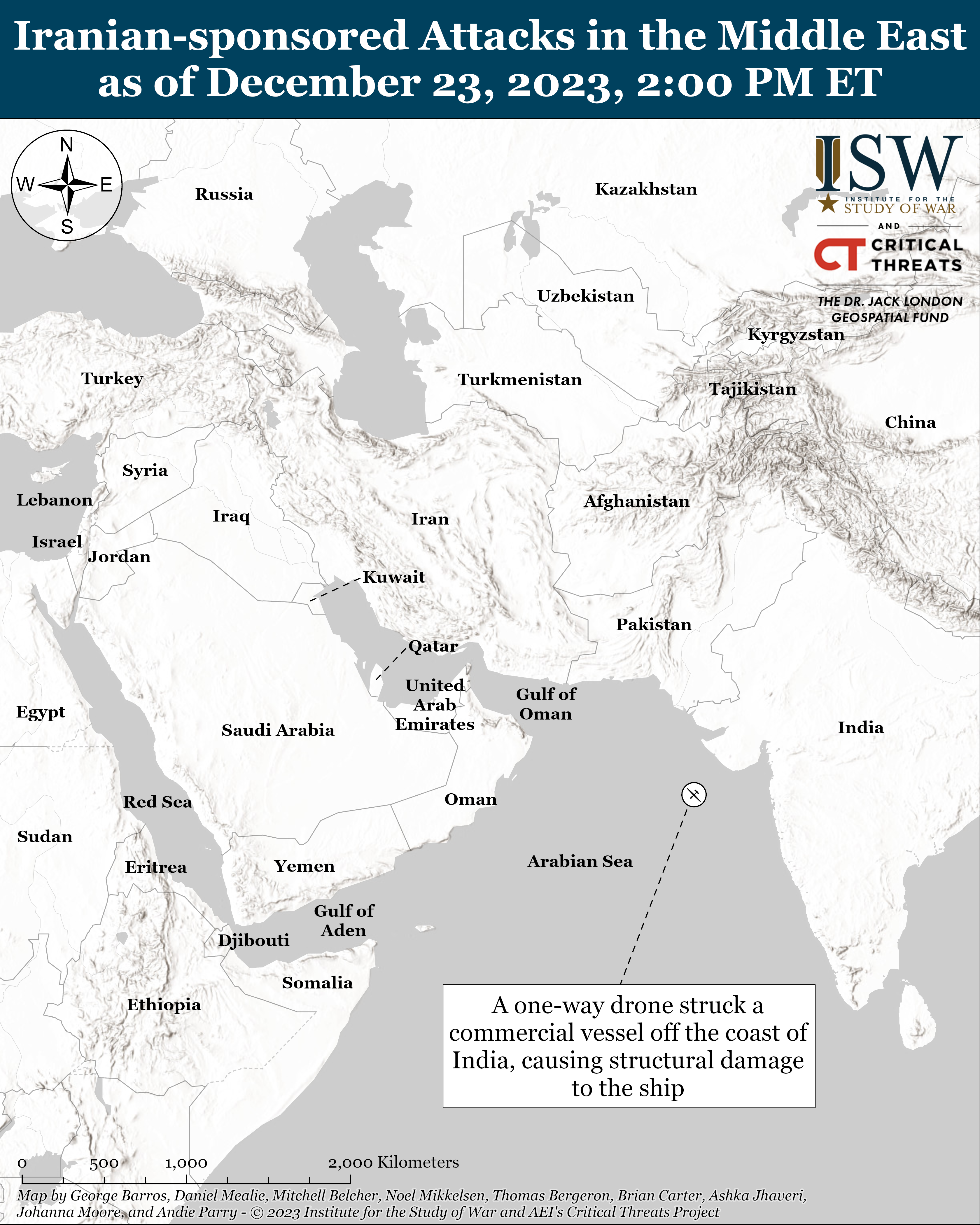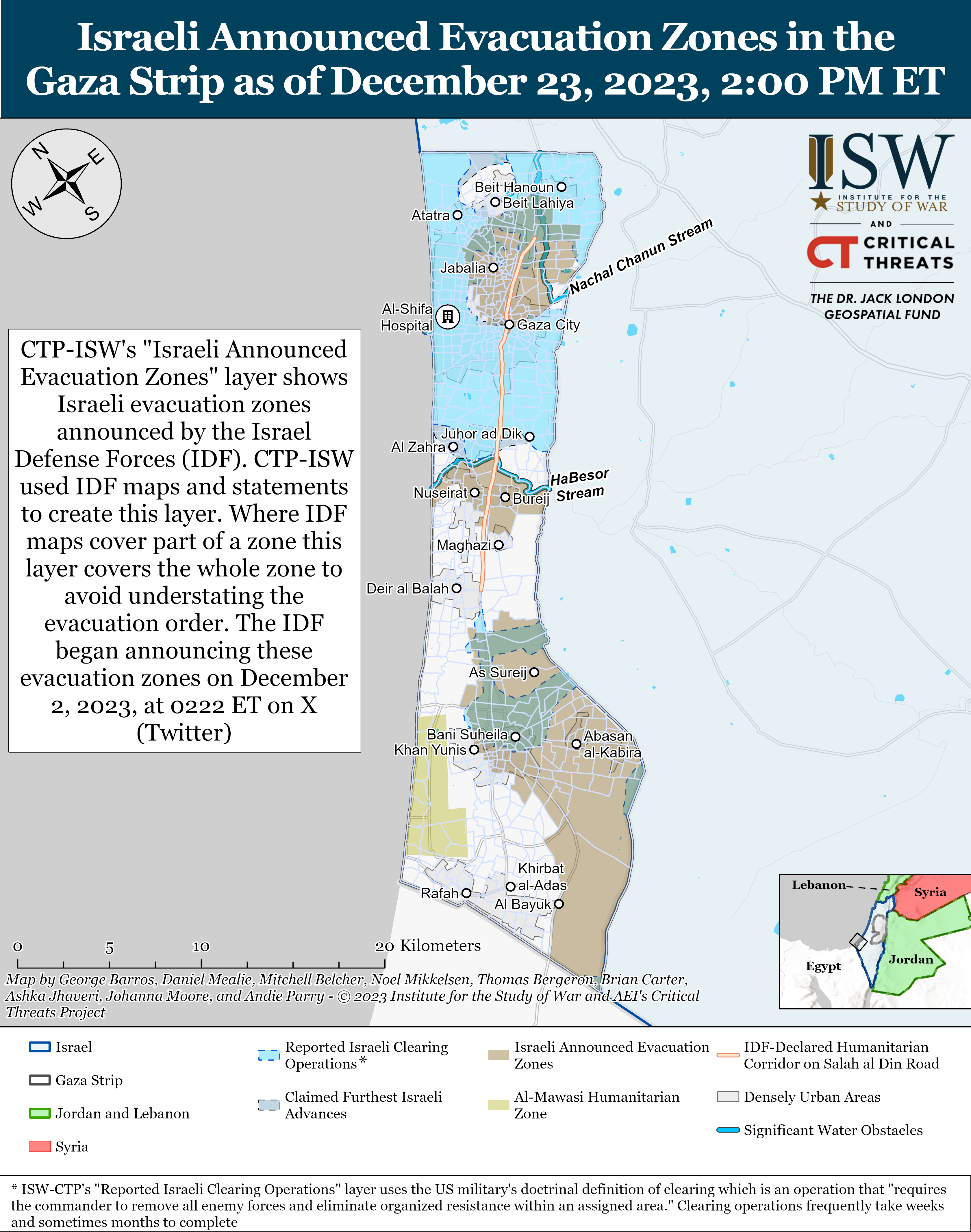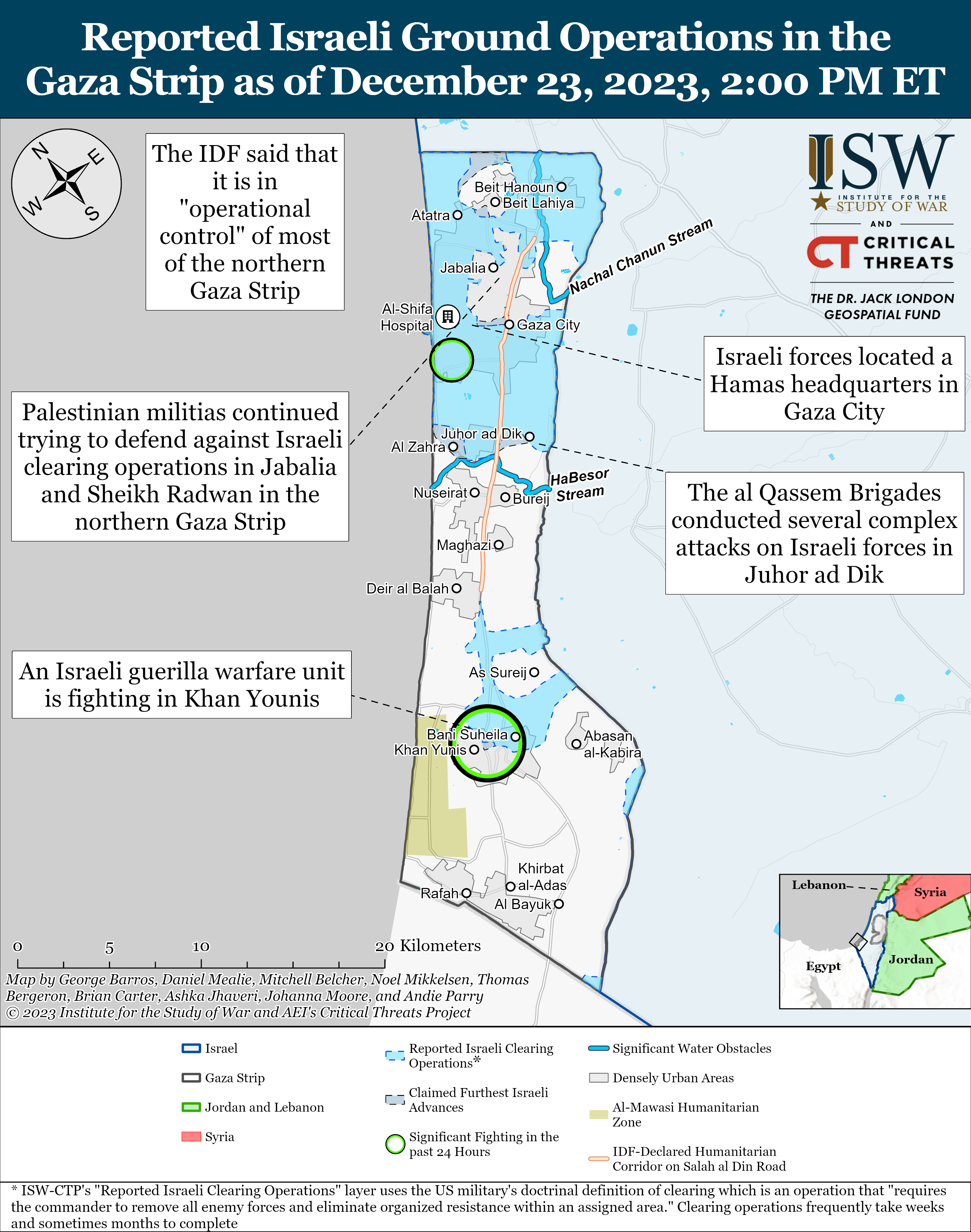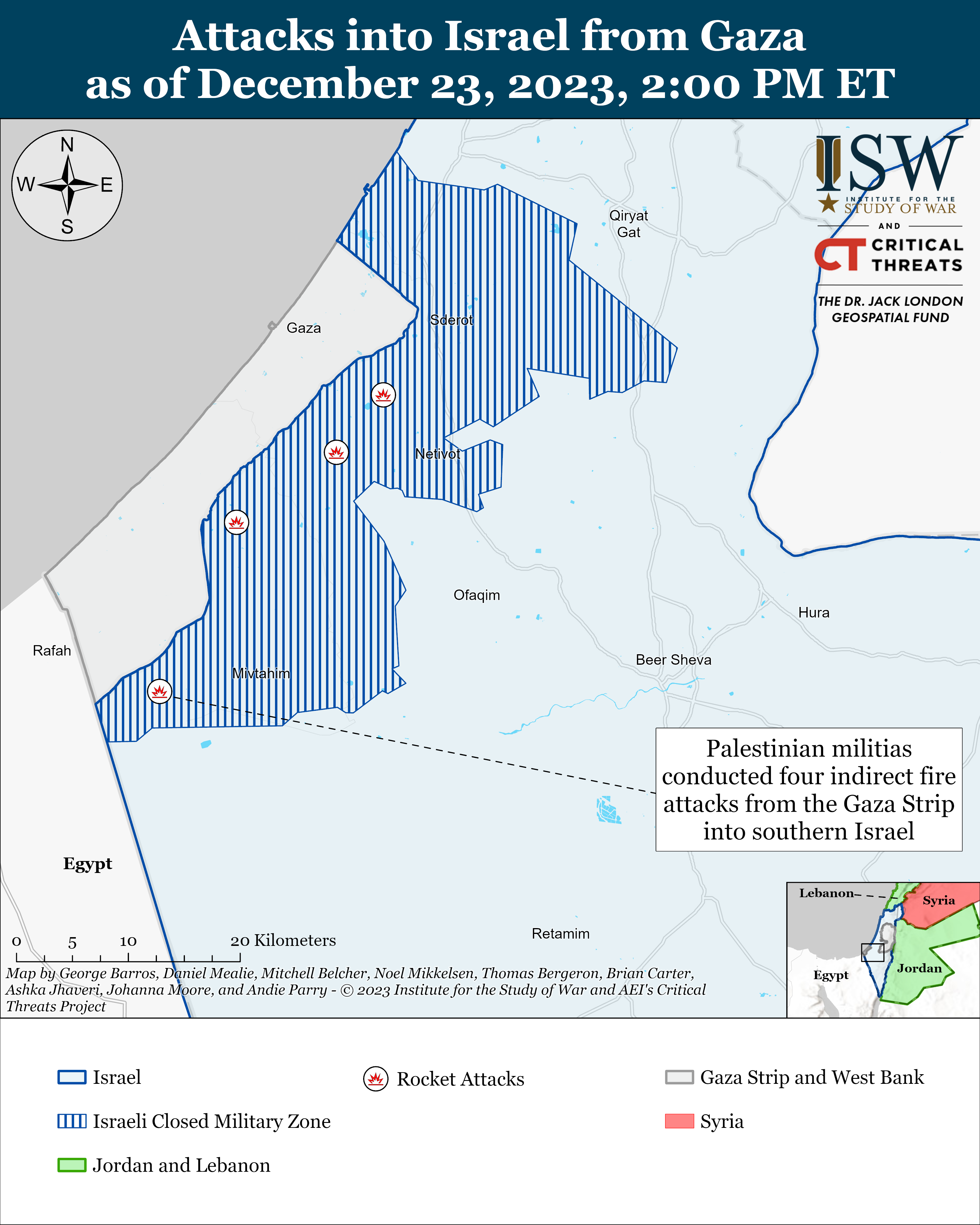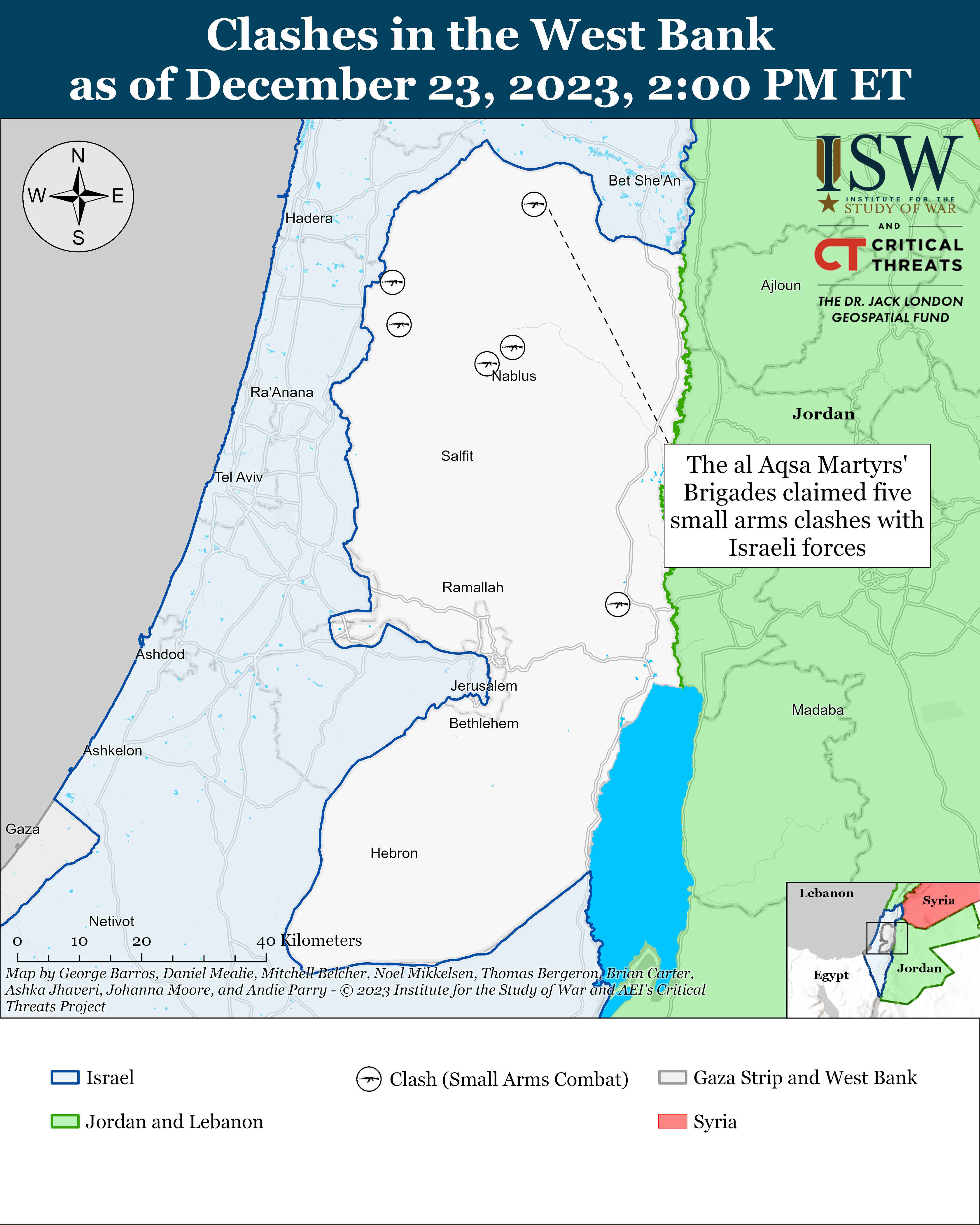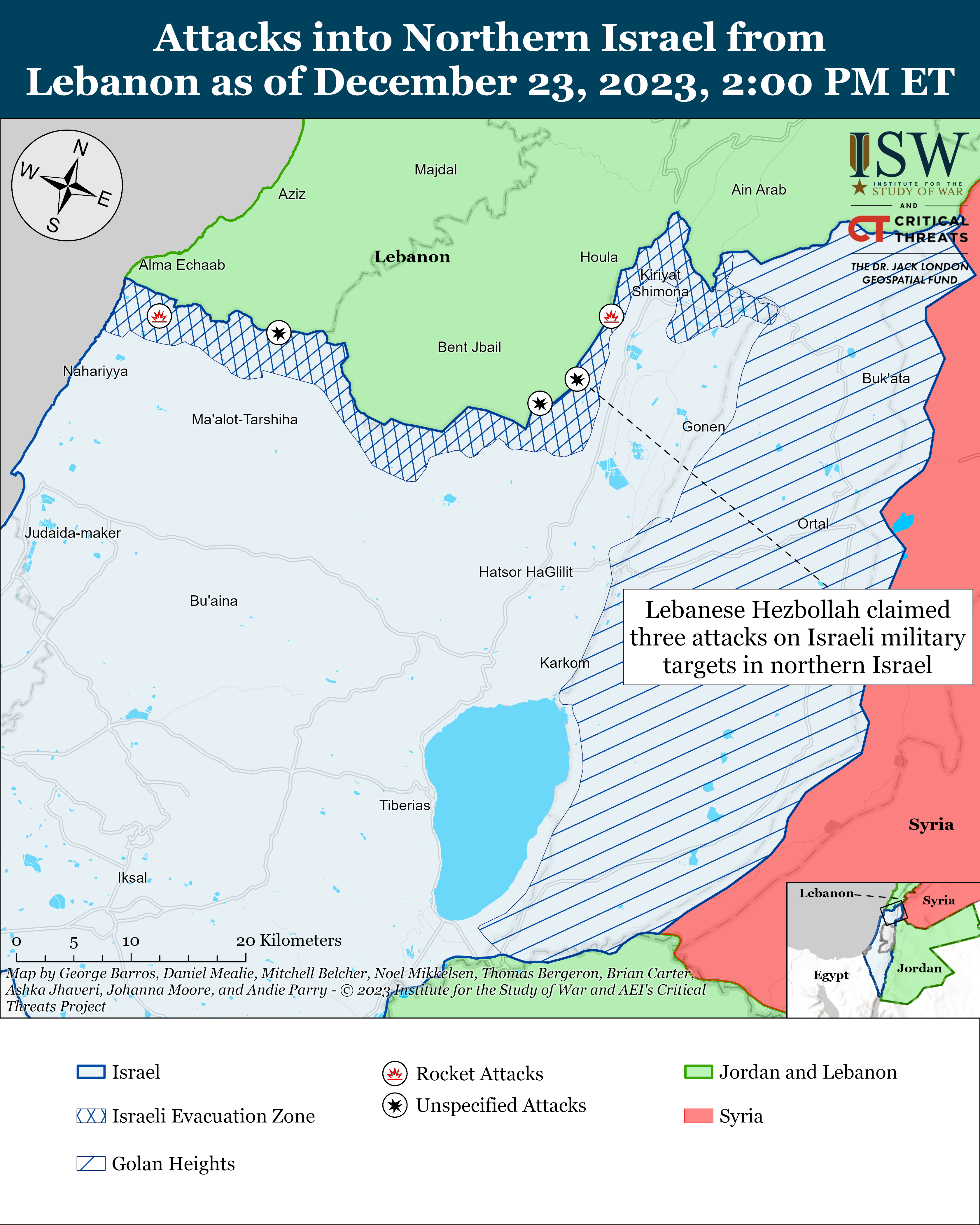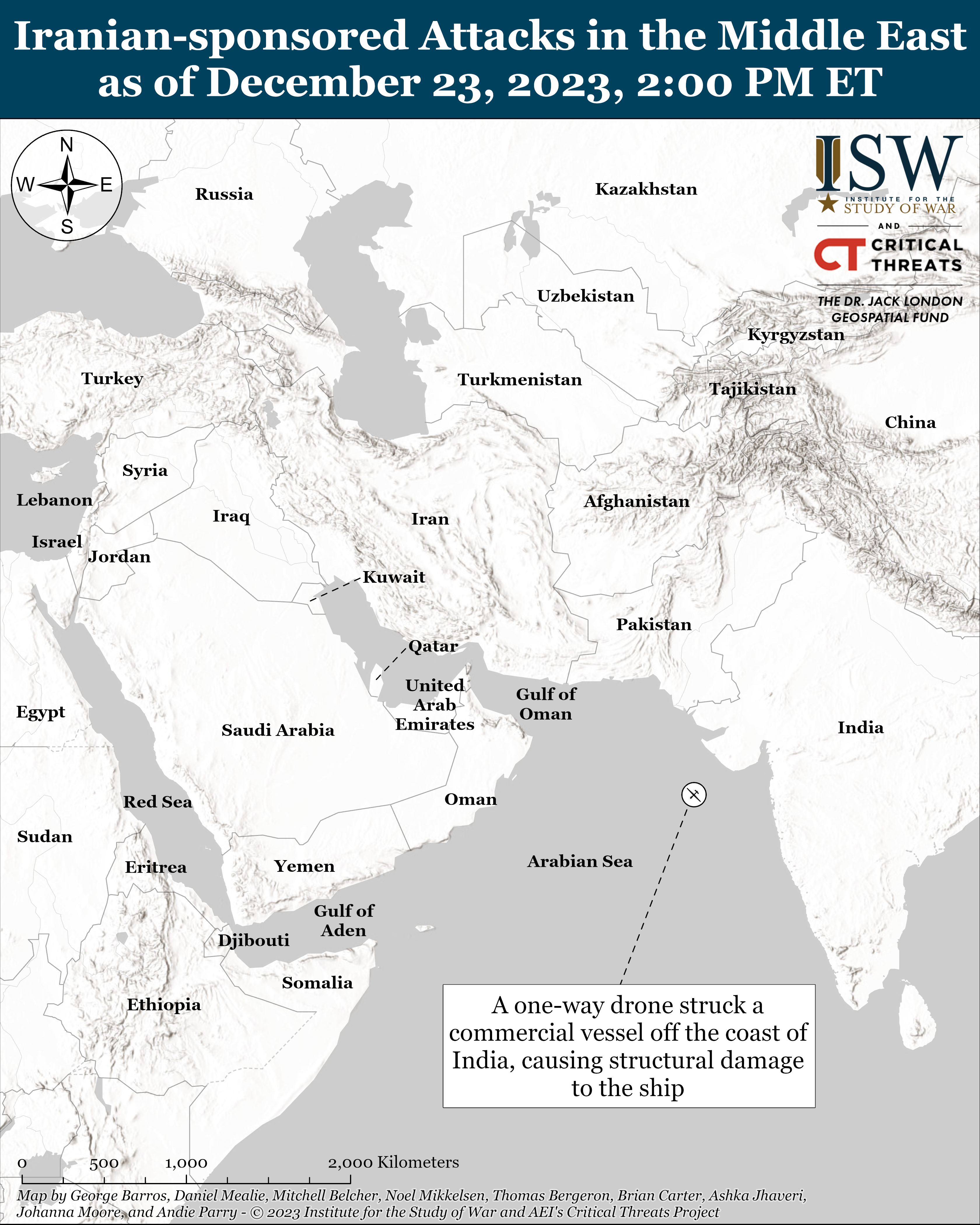Iran Update, December 23, 2023
Nicholas Carl, Ashka Jhaveri, Brian Carter, and Johanna Moore
Information Cutoff: 2:00 pm EST
The Iran Update provides insights into Iranian and Iranian-sponsored activities abroad that undermine regional stability and threaten US forces and interests. It also covers events and trends that affect the stability and decision-making of the Iranian regime. The Critical Threats Project (CTP) at the American Enterprise Institute and the Institute for the Study of War (ISW) provides these updates regularly based on regional events. For more on developments in Iran and the region, see our interactive map of Iran and the Middle East.
Note: CTP and ISW have refocused the update to cover the Israel-Hamas war. The new sections address developments in the Gaza Strip, the West Bank, Lebanon, and Syria, as well as noteworthy activity from Iran’s Axis of Resistance. We do not report in detail on war crimes because these activities are well-covered in Western media and do not directly affect the military operations we are assessing and forecasting. We utterly condemn violations of the laws of armed conflict and the Geneva Conventions and crimes against humanity even though we do not describe them in these reports.
Click here to see CTP and ISW’s interactive map of Israeli ground operations. This map is updated daily alongside the static maps present in this report.
Key Takeaways:
- Iran and its so-called “Axis of Resistance” are signaling their capability and willingness to attack maritime targets beyond just the Persian Gulf and Red Sea. Iran has invested in building “drone carriers” to add to its naval forces in recent years, which will amplify the threat that the Axis of resistance poses to international shipping and other maritime targets.
- Palestinian militias continued trying to defend against Israeli clearing operations in Jabalia and Sheikh Radwan in the northern Gaza Strip. Israeli forces continued executing tasks consistent with holding operations in some areas of Gaza City.
- The al Qassem Brigades conducted several complex attacks on Israeli forces conducting clearing operations in Juhor ad Dik.
- The IDF spokesperson said that the IDF is in “operational control” of most of the northern Gaza Strip.
- Israeli forces continued clearing operations in Khan Younis for the third week as Palestinian militia fighters attempted to defend against Israeli advances.
- Israel’s public broadcaster said that the IDF will transition to the third phase of its ground operation in the Gaza Strip in the “coming weeks” and outlined five aspects of the third phase.
- Palestinian militias conducted four indirect fire attacks from the Gaza Strip into southern Israel.
- Israeli forces clashed with Palestinian fighters eight times across the West Bank.
- Iranian-backed fighters, including Lebanese Hezbollah, conducted five attacks from southern Lebanon into northern Israel.
- The Shia Coordination Framework—a loose coalition of Iranian-backed Iraqi Shia parties—established a special committee to appoint provincial councils and governors.
- The Iranian regime is continuing its diplomatic and informational campaign trying to exploit the Israel-Hamas war to isolate Israel in the international community.
Iran and its so-called “Axis of Resistance” are signaling their capability and willingness to attack maritime targets beyond just the Persian Gulf and Red Sea. A one-way drone struck a commercial vessel off the coast of India, causing structural damage to the ship, on December 23.[1] The vessel is partially Israeli-owned.[2] Israeli media reported that Iran was responsible for the attack, which is consistent with the ongoing anti-shipping campaign that Iran and the Houthi movement have conducted around the Bab al Mandeb in recent weeks.[3] This attack follows the Islamic Resistance of Iraq—a coalition of Iranian-backed Iraqi militias—claiming on December 22 that it conducted an unspecified attack on a “vital target” in the Mediterranean Sea.[4] There is no evidence that the Islamic Resistance of Iraq conducted an attack into the Mediterranean Sea at the time of writing. The claim, nevertheless, signals the readiness of the Iraqi group to participate in the Iran-led attack campaign on maritime targets. Finally, a senior commander in Iran’s Islamic Revolutionary Guards Corps (IRGC), Brigadier General Mohammad Reza Naghdi, threatened to expand the anti-shipping campaign to the Mediterranean Sea and Strait of Gibraltar on December 23.[5] Naghdi frequently makes inflammatory threats toward Iranian adversaries, but his statement is particularly noteworthy given the drone attack off the Indian coast and the claimed attack by the Islamic Resistance of Iraq. Iran and its Axis of Resistance are likely messaging their capability and willingness to widen geographically their anti-shipping attack campaign in response to the United States forming a multinational naval task force to safeguard commercial traffic around the Red Sea.
Iran has invested in building “drone carriers” to add to its naval forces in recent years, which will amplify the threat that the Axis of resistance poses to international shipping and other maritime targets. Iran has built several forward base ships and other offensive vessels, sometimes constructed from converted commercial tankers, to conduct expeditionary and out-of-area operations since 2021.[6] These Iranian vessels can carry drones as well as other platforms, such as fast attack craft, helicopters, and missiles, which facilitates Iranian force projection. These Iranian ships would not likely survive conventional engagements with the United States. They can, however, support attacks on commercial traffic similar to the recent Houthi attacks around the Bab al Mandeb.
Iranian assistance to the Russian invasion of Ukraine will compound further the threat that Iranian drones pose. The war has incentivized Iran and Russia to expand their capacities to manufacture Iranian-designed, one-way attack drones. CTP-ISW previously reported on how Iran is helping to establish drone manufacturing facilities in Russia and Belarus.[7] These facilities will, in theory, allow Russian forces to more rapidly field Iranian-designed drones in Ukraine. The use of Iranian drones in Ukraine is furthermore providing Moscow and Tehran opportunities to test these platforms in a modern combat zone and learn lessons on how to use such platforms more effectively.
Gaza Strip
Axis of Resistance campaign objectives:
- Erode the will of the Israeli political establishment and public to launch and sustain a major ground operation into the Gaza Strip
- Degrade IDF material and morale around the Gaza Strip.
Palestinian militias continued trying to defend against Israeli clearing operations in Jabalia and Sheikh Radwan in the northern Gaza Strip on December 23. The al Qassem Brigades—the militant wing of Hamas—repurposed two unexploded Israeli rocket shells to build and detonate improvised explosive devices (IED) targeting five Israeli tanks in Jabalia on December 23.[8] The militia claimed several other attacks on Israeli infantrymen and vehicles in Jabalia and Sheikh Radwan neighborhood of Gaza City, using anti-personnel munitions, rocket propelled grenades (RPG), and thermobaric rockets.[9] The al Quds Brigades—the militant wing of Palestinian Islamic Jihad (PIJ)—claimed that it destroyed two Israeli vehicles using unspecified explosives in Sheikh Radwan neighborhood.[10] The National Resistance Brigades—the militant wing of Democratic Front for the Liberation of Palestine (DFLP)—claimed that its fighters conducted a sniper attack on Israeli soldiers during clashes in Sheikh Radwan neighborhood.[11] Palestinian militias have claimed nearly daily attacks in Sheikh Radwan neighborhood since the humanitarian pause expired on December 1, suggesting that it is one of the remaining areas with significant Palestinian militia defensive capabilities in the northern Gaza Strip.[12]
Israeli forces continued executing tasks consistent with holding operations in some areas of Gaza City on December 23. Israeli forces identified three Palestinian fighters firing at them on the outskirts of al Shati refugee camp and directed close air support to attack the fighters.[13] Israeli special operations forces (SOF) located a Hamas headquarters south of Gaza City that included a multi-level tunnel network connected to water and electrical infrastructure.[14] The IDF reported that Palestinian militias used the tunnels as a command-and-control center and that the tunnel allowed fighters to move between different sectors of Gaza City.[15] Israeli military analysts told the Wall Street Journal on December 23 that the IDF is increasing its focus on destroying tunnels in the northern Gaza Strip.[16] The al Qassem Brigades mortared an Israeli combat outpost south of Gaza City.[17] Enemy fighters frequently attack holding forces as they execute defensive and offensive tasks to degrade and destroy the enemy force’s military infrastructure.
The al Qassem Brigades conducted several complex attacks on Israeli forces conducting clearing operations in Juhor ad Dik on December 23. The IDF reported on December 22 that it was clearing the Juhor ad Dik area and that it located rocket launchers that Palestinian fighters used to fire rockets at Tel Aviv.[18] The al Qassem Brigades reported on December 23 that its fighters engaged Israeli forces in ”fierce battles” along Israeli lines of advance.[19] This activity suggests that Hamas forces in the area are trying to execute a deliberate defense against Israeli advances. CTP-ISW previously assessed that Hamas fighters are attacking IDF units south of Gaza City likely from relative safe haven in the Gaza Strip’s central governorate.[20] Palestinian militia fighters are also operating north of Wadi Gaza in Juhor ad Dik proper.
- The al Qassem Brigades detonated a mine field targeting Israeli forces.[21] The militia also fired anti-tank RPGs at Israeli tanks and mortars and rockets at Israeli forces.
- The al Qassem Brigades detonated an anti-personnel improvised explosive device (IED) and fired small arms targeting an Israeli patrol.[22]
- The al Qassem Brigades detonated a tunnel entrance rigged with explosives targeting Israeli SOF, after which the militia fighters mortared Israeli forces.[23]
The IDF spokesperson said on December 23 that the IDF is in “operational control” of most of the northern Gaza Strip.[24] CTP-ISW previously reported that the IDF appears to be nearing the final stages of its clearing operations in some of parts of the northern Gaza Strip but that the IDF is continuing clearing operations in other areas.[25] IDF units are executing tasks consistent with the US military’s doctrinal definition of a holding operation in al Shati Camp and Beit Hanoun.[26] The IDF is continuing clearing operations in Juhor ad Dik and Jabalia, however (see above). IDF operations in most of the northern Gaza Strip are not consistent with the US military’s doctrinal definition of a holding operation, which “involves disrupting [enemy] activities in an area and providing a good security environment for the population” and “focuses on securing the population.”[27]
Israeli forces continued clearing operations in Khan Younis for the third week on December 23 as Palestinian militia fighters attempted to defend against Israeli advances. The IDF reported on December 23 that a SOF unit specializing in guerilla warfare has been operating in Khan Younis for weeks.[28] The al Qassem Brigades claimed that its forces lured five Israeli SOF engineers into a tunnel rigged with explosives east of Khan Younis. The militia claimed that they killed all five engineers.[29] The al Qassem Brigades and al Quds Brigades claimed several mortar and rocket attacks on concentrations of Israeli forces east of Khan Younis, some of whom were advancing into Khan Younis City.[30]
Israel’s public broadcaster said that the IDF will transition to the third phase of its ground operation in the Gaza Strip in the “coming weeks” and outlined five aspects of the third phase. The first phase involved beginning clearing operations in the northern Gaza Strip, and the second phase involved expanding clearing operations into the southern Gaza Strip. The report said that the third phase will include the end of major combat operations, a “reduction in forces” in the Gaza Strip, the release of reservists, a “transition to targeted raids,” and the establishment of a security buffer zone within the Gaza Strip.[31] Western media reported previously that this third phase will ”resemble. . . [the] narrow” US counterterrorism campaigns that aimed to kill or capture terrorist leaders in Iraq and Afghanistan.[32] This strategy failed to destroy terrorist organizations in both countries.[33] Targeted raids aimed at killing or capturing terrorist leaders can degrade a terrorist organization but cannot destroy one, particularly one as large, established, and well-organized as Hamas.
Top former Israeli officials and an Israeli war correspondent also published analysis of the war. Former Israeli Prime Minister Ehud Olmert said that Israel now only has two options to end the war: a “ceasefire with living hostages” or a “forced cessation of hostilities with dead [hostages].”[34] The former head of the IDF Operations Directorate argued that the IDF must remain in the Gaza Strip for six more months to cement its gains and accomplish Israel’s stated political objectives of destroying Hamas.[35] A veteran Israeli war correspondent’s report roughly corroborated that timeline.[36] IDF officials told the correspondent that the IDF can accomplish its objectives but that it will take ”a lot of time” and ”a heavy toll in casualties.”[37] The former Operations Directorate chief said that Israel could turn to former Palestinian Authority (PA) security official Mohammed Dahlan in the aftermath of the war.[38] Dahlan is a top Fatah party official currently exiled in the UAE, who previously led a 20,000-strong PA security force with close ties to the United States and Israel.[39] Dahlan said in a November 2023 interview with Time that he would not participate in a future Palestinian government but that he would help rebuild the Palestinian political system.[40]
Palestinian militias conducted four indirect fire attacks from the Gaza Strip into southern Israel on December 23. The National Resistance Brigade claimed two attacks targeting Kissufim and Holit.[41] The al Quds Brigades conducted one rocket attack targeting Kfar Saad.[42] Unspecified militias conducted one rocket attack targeting Beeri.[43]
Recorded reports of rocket attacks; CTP-ISW cannot independently verify impact.
West Bank
Axis of Resistance campaign objectives:
- Draw IDF assets and resources toward the West Bank and fix them there
Israeli forces clashed with Palestinian fighters eight times across the West Bank on December 23.[44] The Hornets’ Nest, which is part of the al Aqsa Martyrs’ Brigades, fired small arms targeting Israeli forces operating in Jenin and Jenin refugee camp on December 22 and 23, respectively.[45] The al Aqsa Martyrs’ Brigades and the Tulkarm Battalion of the al Quds Brigades separately fired small arms targeting three Israeli checkpoints around Tulkarm.[46]
This map is not an exhaustive depiction of clashes and demonstrations in the West Bank.
Southern Lebanon and Golan Heights
Axis of Resistance campaign objectives:
- Draw IDF assets and resources toward northern Israel and fix them there
- Set conditions for successive campaigns into northern Israel
Iranian-backed fighters, including Lebanese Hezbollah (LH), conducted five attacks from southern Lebanon into northern Israel on December 23.[47] LH claimed three unspecified attacks on IDF positions in northeastern and northwestern Israel.[48]
Israeli media reported on December 22 that the IDF will pull reservists from the line in northern Israel and replace them with regular units after the shift to the third phase of operations in the Gaza Strip.[49]
Iran and Axis of Resistance
Axis of Resistance campaign objectives:
- Demonstrate the capability and willingness of Iran and the Axis of Resistance to escalate against the United States and Israel on multiple fronts
- Set conditions to fight a regional war on multiple fronts
The Shia Coordination Framework (SCF)—a loose coalition of Iranian-backed Iraqi Shia parties—established a special committee to appoint provincial councils and governors on December 23.[50] Iraq held its first provincial elections since 2013 on December 18. The special committee will be responsible for negotiating with Iraqi political parties to appoint provincial council members and governors based on party seat allocations. The results of the provincial elections, which are not yet finalized, will determine party seat allocations. The Iraqi Independent High Electoral Commission (IHEC) announced on December 21 that it will release the final results in the coming days.[51] The Iraqi Council of Representatives passed election law amendments in March 2023 that reestablished a list-based system. Under a list-based system, winning parties determine which of their candidates will be appointed to the seats the party won in the election..[52] IHEC released initial results that show that the SCF parties won over half of the total provincial council seats.[53]
US Special Envoy to Yemen Timothy Lenderking said that the United States is attempting to “avoid a wider war” and “use the tools available. . . to encourage the Houthis to dial back their reckless behavior” in an interview with the New York Times.[54] The Houthis already widened the war by committing acts of piracy and terrorism targeting international shipping in the Bab al Mandeb and Red Sea.
The Iranian regime is continuing its diplomatic and informational campaign trying to exploit the Israel-Hamas war to isolate Israel. Tehran is especially focused on trying to isolate Israel from Arab and Muslim states.
- Iranian Supreme Leader Ali Khamenei called on Muslim states to cut ties and trade with Israel during a speech on December 23.[55] Khamenei stated that Muslim populations abroad should pressure their respective governments to this end. Khamenei’s website framed Muslim states as having a responsibility to prevent commercial goods and energy products from going to Israel. This rhetoric is consistent with Khamenei’s previous calls for an international embargo on Israel since the Israel-Hamas war began.[56]
- Iranian President Ebrahim Raisi spoke at a regime-hosted international conference on Palestinian issues in Tehran on December 23.[57] Raisi repeated his usual criticisms of the United States and Israel. Raisi also downplayed the role of Hamas’ October 7 attack in initiating the war and instead framed the war as part of a larger historical struggle between Israel and Palestine. Raisi also framed Hamas’ October 7 attack as a defensive measure in response to Israeli “crimes” against the Palestinian people. Raisi called for an immediate ceasefire.
- Iranian President Ebrahim Raisi held a phone call with Egyptian President Abdel Fattah el Sisi on December 23 to discuss bilateral relations and the Israel-Hamas war.[58] Raisi called on Egypt to do everything possible to stop Israeli attacks into the Gaza Strip. Raisi also framed Israel as “a cancerous tumor” and criticized the United States for supporting Israel, according to the official Iranian readout on Raisi‘s website.
[3] https://www.mako.co dot il/news-world/2023_q4/Article-b431cc842469c81026.htm?sCh=31750a2610f26110&pId=173113802
[31] https://www.kan dot org.il/content/kan-news/defense/660419/; https://www.haaretz dot com/israel-news/2023-12-22/ty-article/.premium/the-unbridgeable-gulf-between-israeli-politicians-rhetoric-and-the-reality-in-gaza/0000018c-8e1e-da31-adff-8e5eb1060000
[34] https://www.haaretz dot com/opinion/2023-12-22/ty-article-opinion/.premium/israels-choice-cease-fire-now-or-dead-hostages-later/0000018c-8e2c-da81-a1bc-cebc4fd00000
[35] https://www.mako dot co.il/news-columns/2023_q4/Article-6c8738498209c81026.htm?sCh=31750a2610f26110&pId=1714799902
[38] https://www.mako dot co.il/news-columns/2023_q4/Article-6c8738498209c81026.htm?sCh=31750a2610f26110&pId=1714799902
[49] https://www.haaretz dot com/israel-news/2023-12-22/ty-article/.premium/the-unbridgeable-gulf-between-israeli-politicians-rhetoric-and-the-reality-in-gaza/0000018c-8e1e-da31-adff-8e5eb1060000
[50] https://www.shafaq dot com/ar/%D8%B3%DB%8C%D8%A7%D8%B3%D8%A9/%D8%A7%D9%84-%D8%B7%D8%A7%D8%B1-%D8%A7%D9%84%D8%AA%D9%86%D8%B3%D9%8A%D9%82%D9%8A-%D9%8A%D8%B4%D9%83-%D9%84-%D9%84%D8%AC%D9%86%D8%A9-%D9%85%D8%B3-%D9%88%D9%84%D8%A9-%D8%B9%D9%86-%D8%AA%D8%B4%D9%83%D9%8A%D9%84-%D9%85%D8%AC%D8%A7%D9%84%D8%B3-%D8%A7%D9%84%D9%85%D8%AD%D8%A7%D9%81%D8%B8%D8%A7%D8%AA-%D9%88%D8%AD%D9%83%D9%88%D9%85%D8%A7%D8%AA%D9%87%D8%A7
[51] https://www.shafaq dot com/ar/%D8%B3%DB%8C%D8%A7%D8%B3%D8%A9/%D8%A7%D9%84-%D8%B7%D8%A7%D8%B1-%D8%A7%D9%84%D8%AA%D9%86%D8%B3%D9%8A%D9%82%D9%8A-%D9%8A%D8%B4%D9%83-%D9%84-%D9%84%D8%AC%D9%86%D8%A9-%D9%85%D8%B3-%D9%88%D9%84%D8%A9-%D8%B9%D9%86-%D8%AA%D8%B4%D9%83%D9%8A%D9%84-%D9%85%D8%AC%D8%A7%D9%84%D8%B3-%D8%A7%D9%84%D9%85%D8%AD%D8%A7%D9%81%D8%B8%D8%A7%D8%AA-%D9%88%D8%AD%D9%83%D9%88%D9%85%D8%A7%D8%AA%D9%87%D8%A7 ; https://www.shafaq dot com/ar/%D8%B3%DB%8C%D8%A7%D8%B3%D8%A9/%D8%B9%D8%AF-%D9%88%D9%81%D8%B1%D8%B2-%D8%B9%D9%84%D9%86%D9%8A-%D9%85%D9%81%D9%88%D8%B6%D9%8A%D8%A9-%D8%A7%D9%84%D8%A7%D9%86%D8%AA%D8%AE%D8%A7%D8%A8%D8%A7%D8%AA-%D8%AA%D8%BA%D9%8A%D9%8A%D8%B1-%D8%A7%D9%84%D9%86%D8%AA%D8%A7-%D8%AC-%D8%A7%D9%84%D9%85%D8%B9%D9%84%D9%86%D8%A9-%D9%85%D9%86-%D8%B9%D8%AF%D9%85%D9%87-%D9%8A%D8%AA%D8%B6%D8%AD-%D8%A8%D8%B9%D8%AF-3-%D9%8A%D8%A7%D9%85


